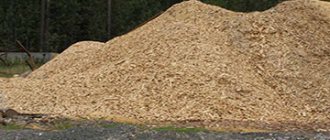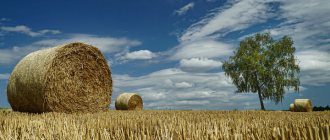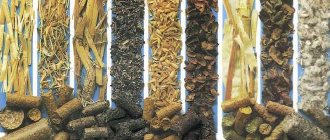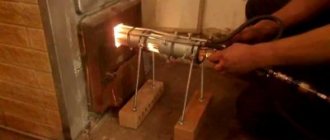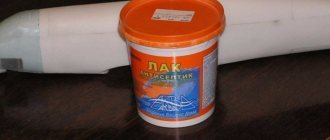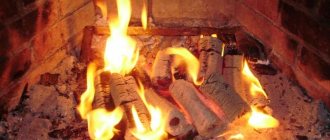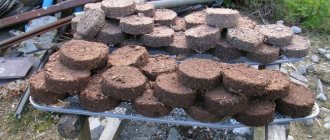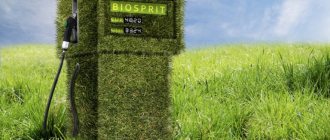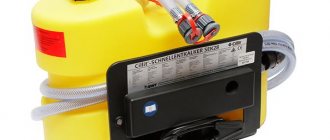In addition to the natural biomass that our planet is rich in, biomass of artificial origin grows on vast agricultural areas. These are cereals and other crops, after processing of which waste remains in the form of stems. First in European countries, and then in our country, they began to produce pellets and briquettes from straw to be used for heating buildings. The purpose of this article is to consider the technology for producing such biofuel, as well as the possibility and feasibility of its production at home.
Main advantages
Fuel briquettes are a modern type of alternative fuel.
They can be used in any stoves, fireplaces, boilers, grills, barbecues. Eurobriquettes are cylindrical billets resembling firewood, or rectangular bricks. Small dimensions allow them to be placed in fireboxes of any size. What are briquettes made from? Most often, wood is used (sawdust, shavings, dust), but straw, paper, peat, coal, seed or nut husks, and even manure are also used. The composition of eurobriquettes can vary significantly, depending on what technology is used in production.
At the same time, all types of raw materials from which firewood can be produced are natural, absolutely natural. Making fuel briquettes at home will allow you to create an environmentally friendly product that will burn almost completely in the furnace firebox and at the same time emit a minimum of smoke.
A home-made eurobriquette can be used to light a sauna stove or heat a home. Since the raw material is compressed quite strongly and the amount of moisture is minimal, the fuel briquette burns for a long time, constantly releasing a large amount of heat. An interesting point was noticed by people who are already actively using such fuel: if you heat your barbecue with eco-wood and fry food on it, if fat gets on the briquettes, it will not ignite.
For stoves, boilers and fireplaces that burn solid fuel, sawdust briquettes are an excellent option. They flare up slowly, but then burn for a long time and emit a large amount of heat. This is explained by the high density of the pressed wood product. The heat transfer from briquettes significantly exceeds the level of heat obtained from the combustion of even the driest firewood, the storage and drying of which took at least a year.
The humidity of fuel briquettes is 8-9%, dry firewood, in turn, has an indicator of 20%. It turns out that a briquette made from the same wood burns better than the wood itself. This effect is formed due to the fact that when burning, fuel briquettes do not need to evaporate a large amount of moisture.
The briquette burns with a stable fire, without splashes, sparks, or crackles, and the amount of smoke released during combustion can be described as small. It is extremely convenient to put such fuel into the stove, since all products have the same correct shape.
A little trick: if you want to create an intense fire with high heat transfer, you should place fuel briquettes in the firebox at some distance from each other and, conversely, to maintain smoldering, you need to tightly connect all the eco-wood in the firebox.
Like any product, fuel briquettes are not without their disadvantages:
- First of all, it is worth noting that they are very vulnerable to moisture, so they are sold in cellophane packaging.
- Briquettes are not able to withstand mechanical stress, especially products made using RUF technology that are not fired on the outside.
- If you want to start making such things at home, it will cost you a pretty penny, although there will certainly be benefits in the long run. The fact is that you will have to purchase a grinding installation, a dryer and a pressing machine in order to carry out the entire cycle of work with raw materials. With suitable equipment, it will be possible to set up artisanal production of fuel briquettes even in your own garage.
Production technology
Depending on the material used, the process technology may vary. But the main steps are the same:
- grinding Facilitates the process of passing raw materials at all stages;
- drying the material;
- pressing;
- cooling and cutting into logs;
- package.
The technology for producing Euro firewood using the pressing method is of two types: cold and hot pressing.
Cold pressing
This method is used in private production with low productivity. The resulting product has low density. But at the same time, you can open your own production at the lowest cost. Here the chips do not need to be crushed and dried; Before pressing, it is moistened to 40%, and starch acts as glue. They use a manual hydraulic press that resembles a jack.
The technology is simple: the chips are poured into a container and compressed by a piston. After this, the finished product is sent for drying.
Hot pressing
This method is used in industrial production with large volumes of products. This will require specialized equipment, including not only a press. The pressing steps are as follows:
- Raw materials are loaded into crushing machines. The material is crushed to fractions up to 2.5 cm in size. This process is necessary if large waste is used as raw material. If sawdust is taken immediately, then crushing is not necessary.
- At the next stage, the material is loaded into drum dryers. Hot air dries the wood to 4% moisture content. This is an important process because... humidity must meet standards.
- After drying, the material enters the grinder, where it is ground to the state of wood flour.
- Pressing is carried out using special equipment that performs 20 piston strokes per second. Compression force 300-1400 kgf/cm2. In this case, the wood becomes very hot, and resins are released that bind wood flour. Adding starch is not required. The compressed material enters the die, which forms the block.
The fuel block comes out of the pressing apparatus as a solid block and immediately goes to the cutting machine.
How to get biogas at home
What raw materials are biogas made from?
- Shredded weeds (grass and leaves).
- Fruit and vegetable pulp.
- Grape pomace.
- Seaweed.
- Waste from fish and meat processing.
- Potato peelings and rotten potatoes.
- Brewery waste.
But most often, manure is used for these purposes as a raw material that is quickly decomposed by bacteria and is cheap.
To obtain fuel from manure or other raw materials, a biogas plant is built. It works on the same principle as septic tanks for autonomous sewerage. Organic matter is processed by anaerobic bacteria, and the biogas released is discharged through pipes and collected for subsequent use.
Making a biogas plant with your own hands helps save about 50% of the cost of a factory device. This speeds up the system's payback. In addition, the construction of the simplest type of installation to begin with allows you to assess how necessary such a device is in the household and invest gradually. This is much easier for the family budget than paying the entire amount at once.
Combustion of baled straw in special fireboxes
There is currently more and more talk about the merits of such raw materials as fuel. In this case, first of all, this means burning baled straw in special fireboxes, which has certainly been implemented in practice in a number of countries. This method of straw disposal also has significant disadvantages. These include:
- the high cost of combustion installations, which reduces the versatility of such fuel for different consumers;
- low efficiency such installations, including due to the low density and humidity of the burned raw materials;
- inconvenience of use due to the large dimensions of the fuel and, accordingly, problems associated with its delivery to the consumer and storage of raw materials in large volumes.
Fuel briquettes from sunflower husks for heating. Advantages and disadvantages
You can heat stoves and solid fuel boilers not only with coal or wood. Fuel briquettes made from agricultural waste are becoming increasingly popular.
For their production, husks (husks) of sunflower, buckwheat, rice are used, straw, nut shells, etc. are processed.
The features of modern technology are such that most often the formation of a fuel briquette occurs only due to pressure without additional connecting elements.
When pressing, one of the components is released from the raw material - lignin, which provides the strength of the briquette.
Fuel briquettes made from husks. Burns for a long time and produces a lot of heat
With all the variety of raw materials, briquettes made from sunflower husks are more popular. This is due to the large amount of heat that such fuel releases during combustion.
Advantages and disadvantages of husk briquettes
In addition to the large amount of heat, what is attractive about briquettes is their density. Why is this so good? Firstly, you save on delivery (they usually charge per volume).
Secondly, the more compact the fuel, the easier it is to store.
Thirdly, if you compare it with firewood, then when you put the same amount of firewood and briquettes (it’s unlikely that you measure firewood in kilograms, because they lay the boiler by volume, and they sell firewood by the cubic meter), you get more heat from the briquettes than from even the best firewood. According to VNII TP, the heat from burning 1 kg of sunflower husk briquettes can heat an area of 50 m2 within 1 hour.
In the table below you will see how much heat the fuel produces. It must be said that fuel briquettes are far from in last place, but those made from husks are practically beyond competition.
| Fuel | Specific calorific value, MJ | Specific calorific value, kW/h |
| Pine firewood | 8,9 | 2,47 |
| Oak firewood | 13 | 3,61 |
| Birch firewood | 11,7 | 3,25 |
| Sunflower husk briquette | 18,09 | 5,0 |
| Straw briquette | 14,51 | 4,0 |
| Wood chip briquette | 17,17 | 4,7 |
| Coal (W=10%) | 27,00 | 7,5 |
| Brown coal (W=30…40%) | 12,98 | 3,6 |
It’s convenient to place briquettes in the firebox: their surface is smooth, you won’t get splinters, unlike firewood, and you won’t get your hands dirty, like when working with coal. There is another advantage: there is no need to improve or remodel the boiler. Did you burn with wood? Just buy briquettes and use them instead of firewood.
Another advantage of briquettes made from sunflower husks is the burning time: they burn for one hundred to one hundred and thirty minutes, and smolder for six or even eight hours.
A significant plus is the low ash content: after burning a kilogram of this briquette, only a matchbox of ash or a little more remains (depending on the quality, but for normal briquettes the ash content is in the range of 4-7%), hence the large amount of heat that a unit of fuel produces: it burns out it's complete. The ash formed after combustion is an excellent fertilizer and can be taken out to the beds.
Cylindrical briquettes from sunflower husks. They endure transportation worse, but burn well
Now about the disadvantages. There is essentially only one drawback: any briquettes (including those made from husks) are afraid of moisture and can crumble when wet. Therefore, they are demanding in terms of storage space: they must be hidden under a roof, in a dry room.
The high price is often cited as a disadvantage. If you look at the cost per kilogram, the price is really considerable. But if you calculate the cost of one kilowatt of energy, the picture turns out to be different.
Want to make sure? Find out the price of a kilogram of firewood, coal, briquettes, etc. Divide this value by the number of kilowatt/hours from the table. Get the cost per kilowatt of heat for each type of fuel.
You may come across the opinion that fuel briquettes of sunflower husks clog the chimney because they contain a lot of oils.
If it is not designed correctly or is faulty, it is possible.
If there is normal draft, the boiler works no worse than with wood and the chimney does not need to be cleaned more often.
Renewable energy sources in Russia. Straw
In 2022, for example, agricultural enterprises of the Russian Federation harvested 72,136 thousand tons of wheat grain, 16,992 thousand tons of barley and 4,719 thousand tons of oats. At the same time, at least 40 million tons of by-product - straw were produced. Typically, one-third to one-half of the resulting straw is plowed back into the ground to restore its fertility. This means that at least 20 million tons of straw were taken from the fields, in one form or another, for storage and processing. 20-25% of this amount is usually used in livestock farming - as bedding for animals and as a feed additive. But there are still 10 million tons of straw left that must be disposed of within a year (since in a year new millions of tons will have to be removed from the fields). Let’s leave aside all possible ways of disposing of excess straw, except for what is close and understandable to us - burning it, but not in an open field (in the Russian Federation, as in many countries, this is prohibited), but in a heat generator. The specific lower calorific value (LCC) of dry straw reaches 5.5 kWh/kg. It is clear that straight from the field it is not completely dry, and its TCV will be lower. Let us use straw with a moisture content of 20% - 4.0 kW∙h/kg for calculations, then it turns out that in the Russian Federation practically free biofuel with a total potential of at least 40,000 GWh is available annually for heat generation. Approximately this amount of heat was spent in the same year 2022 for heating the residential sector throughout Finland.
There are many options for how to manage this wealth, and they differ primarily in combustion technology.
Bales
The most obvious way is to burn the straw directly in the form in which it is removed from the field, i.e. in bales. The type and size of the bale depends on the baler. The most popular pick-up models produce round bales with a diameter of 150 cm and a width of 120 cm. The average weight of such a bale is 244 kg, and the density is approximately 110 kg/m3 (Photo 1).
A number of popular balers form rectangular bales of 240x80x80 cm, weighing about 235 kg and density about 140 kg/m3, however, quite a lot of models are produced with other tunnel sizes, forming bales with a length of 120 to 200 cm (Photo 2) .
It is clear that it is impossible to burn such bales in standard boilers - they are too large. But there are quite a few boilers on the market designed to burn whole bales of straw, as in photo 3.
Obviously, loading such a boiler with a bale of straw requires stopping it for a considerable time, so the maximum heating output is limited to 150-200 kW (by limiting the supply of combustion air) so that the bale burns out no faster than in 2.5-3 hours. In this case, the minimum heating output of the boiler can be 50 kW, and with it it can operate on one load for more than 10 hours.
Despite all the apparent attractiveness of using such boilers for heating small facilities in rural areas, this niche in the Russian market remains unfilled. There is supply from abroad, but it is also very limited. What is the reason? Apparently, straw as a fuel is problematic (see Table 1)
Table 1. Energy value of straw (per ton) at 15% moisture content
| Type of straw | Heat of combustion, kW∙h | Equivalent amount of heating oil, l | Ash content, kg |
| Wheat | 4 032 | 396 | 57 |
| Barley | 4 116 | 406 | 48 |
| Rapeseed | 4 004 | 393 | 62 |
As can be seen from the table, the ash content of straw is quite high (for woody biomass it does not exceed 1%). In this case, the ash becomes soft already at 800 °C (unlike ash when burning wood, which begins to soften at a temperature not lower than 1100 °C), which leads to the formation of ash and slag agglomerates in the boiler firebox, which prevent combustion. Because of this, it is necessary to clean the boiler more often, and the cleaning itself is more labor-intensive than required for wood-fueled boilers.
Of course, manufacturers of boilers for whole straw bales also offer boilers of greater power, with automated, almost continuous, loading, and automated cleaning. However, at the same time, the cost of equipment increases so much that reasonable doubts arise about the possibility of recouping these additional capital costs someday in the foreseeable future due to cheaper fuel. In other words, even at the cost of additional costs for fuel preparation, but any method of burning looks more promising straw in universal boilers, for example pellet boilers.
Agropellets
Straw pellets, or agropellets, are made using the same technology as pellets from wood waste, and since the moisture content of straw is usually lower than that of fresh wood, you can save on drying the raw materials. Interestingly, higher quality agropellets are obtained from stale, “gray” straw. This is explained by the fact that fresh straw contains noticeable concentrations of potassium, chlorine and sulfur compounds, which greatly affect slagging and make the slag and combustion products aggressive towards the boiler metal. So, as British scientists discovered, if straw has been left in the rain for a week or two, a significant part of the unwanted substances are washed out of it. Danish thermal power plants that burn straw on an industrial scale also practice treating straw with steam or hot water. It must be said that this approach was not understood in the native Palestines: using stale straw in the production of pellets is all right, but any additional operation like washing/steaming straw inevitably increases the cost of agropellets and pushes them out of a market already filled with cheap and less problematic wood pellets. Therefore, agropellets, as fuel, have the same disadvantage as straw - high ash content (see Table 2)
Table 2. Comparative properties of fuel pellets made from straw and woody biomass.
| Density, kg/m3 | Humidity, % | UTS (lowest), kW∙h/kg | Ash content, % | |
| Straw pellets | 600 | <10 | 4,17 | 5 |
| Wood pellets | 650 | <10 | 4,86 | 0,5 |
Pellet boilers for the household segment, as well as universal solid fuel boilers with a pellet burner, as in photo 4, are mostly designed for burning wood pellets, the ash content of which does not exceed 1%.
This is explained primarily by the fact that manufacturers strive to simplify and reduce the cost of burner and boiler equipment as much as possible, because only under these conditions can heating a private house using pellets win competition with propane and diesel fuel. When burning agropellets, the design of the burner and boiler must provide for the constant removal of ash and slag, but a simple and reliable way to organize this process in a low-power boiler has not yet been invented.
However, pellet boilers for domestic and commercial power ranges are also available on the market, the manufacturers of which allow the combustion of fuel with an ash content of up to 3%. This opens a window of opportunity for using agropellets as fuel, provided they are mixed in the right proportion with wood pellets. As a result, a user located further from forests than from fields can achieve significant savings through the use of cheap local fuel.
At the same time, on the Western European market there is a fairly wide offer of boilers and biofuel combustion systems that can operate on agropellets, but their use becomes economically justified only with a boiler plant power of 100-150 kW and above. The most “well-established” technical solution of this kind is a solid fuel boiler with a movable grate (Photo 5).
Photo 5: Solid fuel boiler FerroliWOODMATICSGM
Fuel is supplied to such a boiler by a screw or plunger loader. A grate with a hydraulic or electromechanical drive allows you to efficiently burn solid fuel with a high ash content (up to 7%). Fully automatic removal of ash from the combustion unit is ensured by a scraper under the grate and an auger for unloading ash. The walls of the combustion chamber are covered with a refractory lining. The primary and secondary combustion air supply areas are designed to ensure combustion is as complete as possible. In such boilers, combustion efficiency of 85% or higher is achieved.
Another promising technical solution for agropellet boilers is the “fluidized bed” combustion technology, which came from the “big” energy sector. Using this technology, Tambov State Technical University has developed a series of heating boilers in which the fluidized bed is formed by the granules themselves, particles of their coke residue and ash (Photo 6).
The temperature in the layer reaches 1000-1100 °C, which is sufficient for ignition and stable combustion of coke residue. Fuel granules in constant motion destroy the ash and slag agglomerates formed in the layer, so the focal residue has a powdery structure and is easily removed from the boiler.
Gasification
Gasification is a thermochemical combustion process with three phases (pyrolysis, oxidation, reduction), as a result of which dry biomass is converted into a combustible gas.
Gasification of biomass has a number of advantages compared to its use as a solid fuel:
— when burning gas, no ash, slag or resins are formed;
— gas combustion is easily regulated and automated;
— combustion of generator gas is characterized by complete combustion and high flame temperature.
However, unlike woody biomass, the technology of straw gasification is still poorly developed. The main difficulty lies in the formation of solid agglomerates on the internal surfaces of the gas generator. Developers are trying to overcome this difficulty, for example, by supplying water vapor instead of air to the gas generator, or by introducing various additives into the original biomass. The geography of research is wide: from Japan and China in the east to Denmark and the Netherlands in the west. Unfortunately, the Russian Federation remains on the sidelines for now.
How they did it in Denmark
It so happens that in the development of this energy source, all countries are following in the footsteps of Denmark. In 1993, when no one in the world had any experience producing energy from biomass, the Danish Government entered into a political agreement with energy producers, which obliged them to use biomass (mainly straw from local fields) for energy production by the year 2000. energy production up to 1.4 million tons. By 2016, 15 CHP plants operating entirely or partially on straw had been built in Denmark (Photo 7).
They burned a total of 1.6 million tons of straw per year. The boilers of these CHP plants use several straw combustion technologies:
— burning straw or a mixture of straw and wood on a movable grate;
— co-combustion of ground straw with wood or coal dust;
— co-combustion of coal and straw pellets in a fluidized bed.
Overall in Denmark in 2016, renewable sources provided 25% of all energy consumed, and 15.6% of this came from straw combustion.
Production
The production process, as we have already said, is quite simple, even though it takes place at home.
To make briquettes for heating stoves with your own hands you need:
- Prepare high-quality raw materials, grind them to the desired consistency, and dry them. In order to improve the quality of combustion, paper can be added to any raw material.
- If necessary, add a binding element (clay, lignin), add water, and load it into the press machine.
- Press the product into a suitable shape at high pressure and preferably high temperature.
- Dry the finished product and, if possible, package it to protect it from external factors. When drying, you can use rags and paper that can draw out any remaining moisture from the briquette.
Having carried out all this work, you will receive excellent fuel, which can be used to easily and quickly heat a bathhouse and heat a house. At the same time, over a long period of time, you will experience the benefits and cost savings from using such eco-drives.
Note that during operation you should try to achieve a briquette moisture content of no more than 10-12% so that they burn well. Industrially produced briquettes have a moisture content of less than 10%.
To make sure of the excellent characteristics of this type of fuel, you can buy yourself some Euro briquettes to try in any store. At the same time, to create a suitable atmosphere, you can sometimes light a fireplace or stove with ordinary wood, because the use of different types of fuel is not mutually exclusive.
Back in the middle of the last century, in many regions of our country, where there were problems with wood, but livestock farming was developed, dung was a popular type of fuel. Then they were supplanted by coal supplies and gasification, but the topic of producing fuel briquettes from manure is still interesting.
Nowadays, manure is most often used in organic farming, as a natural and useful fertilizer. But these are not all areas of use of this natural raw material. We talked about adobe houses, where manure can also be used as a filler for construction briquettes. In addition, organic material is used in the production of biogas, which is also an alternative fuel.
Preparation of dung. Tsimlyanskaya village, 1875–1876
But we will not talk about biogas, but specifically about fuel briquettes made from manure, dung, which were actively used by our ancestors to heat houses with stove heating.
Dung is not just manure, animal waste. This is manure mixed with straw, sawdust, hay, pressed into small briquettes, bricks or cakes, and dried. In this form, manure becomes a good fuel for heating, for example, a greenhouse, a bathhouse or a country house, completely replacing firewood and even coal.
For comparison, here are the approximate energy content of various types of biological fuel:
| Fuel | MJ/kg | kW h/kg |
| Dry manure | 16 | 4,4 |
| Fresh wood with 60% moisture content | 6 | 1,7 |
| Street-dried wood with a moisture content of 20%, ordinary firewood | 15 | 4,2 |
| Straw in bales | 15 | 4,2 |
| Coal | 28 | 7,8 |
As you can see, the specific calorific value of dry manure is even slightly higher than that of firewood that was dried outside. In addition, dung burns with a smoldering flame; users note that their combustion properties are similar to brown coal.
The main advantage of manure as an alternative fuel is its efficiency. If you have your own farm - cows, goats, sheep, rabbits, other animals - then the fuel is absolutely free. You can ask your neighbors who farm and do not actively use manure themselves. A whole truck of manure can be ordered and purchased; it will cost about 11 thousand rubles.
Another plus is that ash from dung will be an excellent fertilizer; it is an environmentally friendly and waste-free fuel.
The main disadvantage of dung is that it takes a long time to make such fuel with your own hands; you have to put in a lot of effort. In addition, the very thought of having to tinker with such organic raw materials, animal feces, scares many people away. Note that, according to numerous reviews, there are no unpleasant odors during the burning of dung. Bread was previously baked in Russian ovens using this fuel.
In the process of producing briquettes from manure, of course, there is little pleasant, we agree. But in general, everyone involved in livestock farming is faced with the disposal of organic waste, so why not do it for the benefit of the farm.
Basic properties and classification of material
Briquettes are made from various waste from woodworking and agricultural enterprises:
- from sawdust, bark, branches;
- made of straw;
- from plant waste;
- from grain husks;
- from reeds;
- from peat;
- from waste from flax processing;
- from screenings of hard coal;
- from grapevine.
Due to its versatility, this type of fuel can be used in various fields: in boiler rooms; for heating residential buildings, baths, saunas, greenhouses and many other objects.
Externally, briquettes are similar to ordinary firewood; their diameter is 10 cm and length is about 25 cm. The strength of this material is given by the substance lignin, which, under the influence of pressure and temperature, begins to melt and bind its particles.
Advantages of fuel briquettes:
- Emission of a small amount of soot and smoke, the ash content of Eurowood does not exceed 1.5%. If peat briquettes are processed, the ash can subsequently be used as phosphate or lime fertilizer.
- The burning time of wood briquettes is three times longer than that of conventional firewood, so they do not need to be loaded into the stove frequently.
- Affordable price.
- Compact and easy to transport.
- During combustion, environmentally friendly fuel does not emit harmful substances.
Depending on the briquette manufacturing technology, they can have different shapes:
- NESTRO is Euro firewood, which is made in the form of a cylinder. An impact press is used for their production.
- Pini&Kay are multifaceted products with holes. For their manufacture, a special press is used with a working surface pressure of 1100 bar. After pressing, they undergo a heat treatment procedure, as a result of which they acquire a dark brown tint.
- Briquettes ruf (ruf) after processing take the shape of a rectangle. They are produced using a hydraulic press with a pressure of 400 bar.
Equipment used
In order to make a fuel briquette with your own hands, you need to choose the right press or chipper. When choosing a press, you need to decide what shape and area the elements will have. The most commonly produced are round and rectangular briquettes.
Professional equipment includes auger, mechanical impact and hydraulic presses. The first device is capable of producing octagonal elements with a small hole in the center. They are distinguished by maximum density, therefore they provide the longest burning time. The hydraulic press produces rectangular elements with the lowest density, which ensures high material consumption. Making fuel briquettes at home using a mechanical impact device gives you the opportunity to make material of any shape. In this case, the elements have an average density.
You can make a machine for making briquettes at home. To do this, you will need a simple press and a mold (a sewer pipe with drilled holes). Please note that during the manufacture of the presented product you will need to take into account the length of the firebox.
Pricing and determination of retail or wholesale prices for briquettes
Different businesses use different pricing methods. However, regardless of the method chosen, you must first have certain information that will allow you to make the right decision. The most important information for pricing is:
- acceptable price level for buyers;
- competitors' prices;
- expenses for the cost of finished products;
- other expenses: advertising, delivery, company management.
Much of this information for determining sales prices comes from market analysis. First you need to answer the question: “What price is the buyer willing to pay for the product?” Next, we determine at what prices competitors sell. And then we analyze the costs of producing and selling briquettes, which should be covered by the selling price:
- Direct purchasing costs are those costs that can be directly associated with each batch of purchased materials and raw materials for production. They can be attributed to a person without any additional calculations for products including them: purchase of raw materials, fuel, transportation, packaging.
- Fixed costs – carrying out operations is also a fixed cost that does not depend on the number of goods sold. This includes wages (if you hire workers), overhead, electricity, waste removal, financial and accounting services, insurance, security and controls, telephone and internet, office supplies, promotions and advertising, and office rent.
For one ton of straw briquettes, individual clients are willing to pay up to $120. Enterprises and large boiler houses count on wholesale discounts of up to $80 per 1t.
Despite the relatively new type of solid fuel, there are already many competitors on the market today. Some of them produce briquettes from sawdust or willow branches
Therefore, it is important to stand out among competitors with a high-quality product with good combustion and heat transfer performance. It is equally important to regularly analyze the degree of customer satisfaction in different market segments, which are constantly changing
To solve these problems, you should know how to conduct marketing analysis for small businesses. Market analysis will not only allow you to track undervalued segments, but also create a strategy for business development in accordance with the growth rate of its potential. And also to identify the most favorable entry point into the market.
BUILDING A BUSINESS STRATEGY FOR ORGANIZING PRODUCTION AND SALES OF BRIQUETTES
When organizing the production of straw briquettes, you should analyze the current market situation and the conditions under which you will have to work. What are the pros and cons, strengths and weaknesses of a manufacturing enterprise. What should be taken into account to scale a business, and what are barriers and obstacles to the development of the project (all kinds of threats to the business). This type of production has an indisputable trump card - the production of energy from renewable raw materials. The chances of success are high, but the challenges and obstacles have not been canceled. Factors that will positively hinder the achievement of business success should be taken into account. To create a successful business, follow a number of effective steps:
- Creating a profitable offer while maintaining affordable prices.
- Organizing the supply of straw in sufficient quantities at low prices.
- Searching for regular customers from other regions and areas.
- High-quality equipment for the production of high-quality briquettes.
- Training of hired workers or search for qualified employees with skills and experience in the production of briquettes.
- Cooperation with organizations and institutions in the field of environmental fuels.
- Increasing public awareness by attracting more interest in the use of environmentally friendly fuels.
- Positioning the product as an alternative to minerals in the energy sector.
- Obtaining support for any funds allocated for special programs to protect the environment.
- Investment in the economic development of the region and the creation of new jobs.
The most likely difficulties and obstacles that you will most likely encounter when starting this manufacturing business:
- Poor visibility of the product in the residential heating fuel market.
- Insufficient number of regular customers.
- Interruptions in the constant supply of industrial raw materials.
- Insufficient production capacity.
- Rapid emergence of competitors and new participants in your market.
- Insufficient project funding.
- Risks associated with the development of new customer needs.
- Variability of legislation and taxation rules in this area of production.
- Unstable government policy towards small and medium-sized businesses in general.
- A sharp decline in the purchasing power of the population due to financial crises.
It is important to predict customer expectations in advance and satisfy them the first time they purchase a briquette.
Segmentation of buyers of briquetted fuel
Customer expectations will be shaped depending on their type:
- Individual clients (individuals) will expect a high quality product, and for them this means a high calorie content (density) from an appropriate degree of compression (without crumbling or delamination of the briquette). The form of packaging is also important to them: convenient paper bags of 10 kg for barbecue dressing. Or large bags like big-bags with a total weight of up to 1000 kg for heating needs.
- For large boiler houses, the wholesale price will be primarily important. High density indicators after pressing to the maximum degree are also important for them. Packaging is not important; they are always ready to receive briquettes in bulk.
Customers' opinions
How objective can reviews of peat heating briquettes be? The catch lies in the many external factors that affect the effectiveness of their use. First of all, this concerns the boiler, since the efficiency of heating with briquettes made from sawdust or other source material depends on its parameters:
- We decided to heat the boiler with sawdust briquettes as an experiment. The heat transfer turned out to be extremely high. However, fuel consumption has also increased. Alas, our old boiler had too much draft. Now we use them if we need to quickly heat the house;
- First, we ordered the cheapest fuel briquettes in the form of tablets. They burned out quickly and produced a relatively large amount of ash. Then we decided not to save money and bought a batch of RUF Euro firewood. The differences turned out to be significant - the complete combustion time increased, heat transfer increased;
- We approached the issue of heating the house thoroughly - we purchased a long-burning boiler. They took peat fuel briquettes for testing. After much testing and experimentation, we found out that it is best to use them together with firewood in a 1/3 combination (briquettes, firewood).
The video shows a homemade installation for making fuel briquettes:
DIY heating briquettes
Is it difficult to make wood heating briquettes at home without special equipment? To do this, you will need the simplest lever press and a mold for Euro firewood.
Sawdust or waste paper can be used as feedstock. Often these components are combined with each other to improve quality. To obtain a homogeneous mass in a peat heating briquette, a binder component is required. It could be water or clay. Then you will need to complete the following manufacturing steps:
- Crushing the feedstock and adding a binder component.
- Filling the form, pressing.
- Drying the workpiece.
Factory heating briquettes RUF are produced using the same technology. The difference lies in pressure and production volumes. At home, to provide fuel for the entire heating period, production time can take from 7 to 20 days.
Market situation
It is for heating houses that fuel briquettes have become especially popular, since the heat from their use will be much more pleasant than the heat coming from coal or natural gas. The great demand for European firewood is growing strongly, but there are no prerequisites for the modern market to become oversaturated with such products. In the Russian Federation, the market for such material is already actively gaining momentum. Many people who buy country property are well aware that it is possible to heat their purchased homes using wood waste boilers and fireplaces. So the equipment is purchased with great joy. And in Europe, heating homes using fuel briquettes is already commonplace. Many supermarkets may sell different packages of granules of varying sizes.
Sales market for fuel briquettes
And yet, fuel briquettes are perfect for use in production facilities. Every factory that uses solid fuel for heating may well end up switching to fuel briquettes. Thus, the business plan for the production of fuel wood briquettes will be more profitable.
PRESSING EQUIPMENT FOR THE PRODUCTION OF FUEL BRIQUETTES
To produce straw briquettes, you can use different types of presses:
- Mechanical impact briquetting press. The most popular type of straw briquetting press. His trailer is quite simple and reliable. The straw mass is kneaded layer by layer into the shape of a dense cylinder, which gradually moves along the stabilizer. At its end, the cylinder breaks off with a special knife or under its own weight. Such briquettes usually come in different lengths. They retain all the advantages of the ecological solid fuel of straw briquettes, but lose their aesthetic visual properties.
- Hydraulic press for briquetting. Briquettes produced by this group of pressing machines have a cylindrical or RUF shape (a patented shape that gives additional properties to the briquette: uniform burning with greater heat transfer, increased resistance to moisture, etc.). Due to much greater pressure, briquettes of this type are more compact and, as a rule, do not crumble. They are the optimal fuel for fireplaces, but nothing prevents their use in any other heating devices.
- Screw press for extrusive (continuous) briquetting. This type of press is distinguished by its special productivity and good quality of compression of the straw mass. In fact, these presses form pallets - these are thin cylindrical briquettes of the highest quality (pencil thick). The disadvantage of screw presses is higher operating requirements and increased wear of working units. When briquetting, chopped straw is subjected to high pressure, obtained by pressing it with an auger in a sleeve (similar to the principle of a meat grinder). But the final shape is given by a special bushing at the end of the screw. In this case, the end surface of the briquette is sealed with an electric heater. It helps release more water vapor from the already dry material. This additional process also makes it possible to increase the moisture resistance of the finished product.
Market analysis
The rapid development of the biofuel market is associated, first of all, with the energy challenges that exist in European countries and the significant rise in cost of traditional fuels. In Russia, interest in the production of fuel briquettes began to appear at the turn of the 21st century, when the country's first pallet manufacturing enterprises were organized. In 2004, the biofuel industry formed into an independent business line, which in recent years has undergone a number of significant structural and qualitative changes.
If at the initial stage of the development of the industry in the country there were only about 30 active manufacturers, and of these only 3-4 trading companies were able to enter the international market, now their number has not only increased significantly. Industry magazines and reference books appeared in Russia, and conferences and seminars began to be held on topical issues in the development of the alternative fuel market.
These efforts have led to the fact that since 2002, the number of European firewood producers has doubled every year. According to experts, this trend will continue in the future. This happens even under such conditions that domestic enterprises for the production of briquettes constantly experience a shortage of raw materials. If this fact in itself is paradoxical for Russia, then other restraining barriers are quite natural: the country does not yet have an established production of special equipment, there are no qualified specialists, and the entrepreneurs themselves have a lack of experience in operating in this product market.
The consequence of all these circumstances is a constant rise in price (by 5-80%, depending on the region) of purchase prices for fuel briquettes.
Abroad, Russian products from this industry cost 80-230 euros per ton. This is facilitated by the gradual accumulation of experience in the industry market by domestic entrepreneurs, the widespread popularization of this type of fuel among the population, the high profitability of the production itself (at least 15%), and the active investment of funds from foreign companies in the domestic industry.
At the moment, the colossal potential of domestic bioenergy is undeniable. But, according to experts, for continued market growth, two basic conditions must be met:
- It requires a transition from competition between domestic producers to cooperation, which will lead to the exchange of experience and knowledge.
- Government support for the industry is needed.
To date, certain steps have already been taken in this direction. Thus, the Federal Energy Strategy for the period until 2022 was adopted, which provides for the creation of a more favorable investment climate for producers of renewable energy sources, the widespread introduction of modern technologies for the production of biofuel, and the organization of production of domestic equipment for this industry.
It is expected that as a result of the implementation of this strategy, the share of renewable energy sources in the country's fuel and energy complex will reach 0.6% in 2022 (in European countries this figure is going to be increased to 15%). There is a special commission in the State Duma of the Russian Federation that is developing draft laws in the field of alternative energy.
In a word, bioenergy in Russia has the necessary prospects to soon become a developed, environmentally friendly, competitive and profitable sector of the national economy. In the foreseeable future, the demand for fuel briquettes will only increase, which will lead to increased competition and the survival of only efficient manufacturers in the market, the number of which will also grow.
Raw materials for production
The raw materials for production are waste from agriculture, waste from woodworking and furniture production. To produce one cubic meter of fuel blocks, four cubic meters of waste will be required.
Today, the following types of raw materials are used for the production of European firewood:
- different types of wood;
- straw;
- peat;
- husks from cereals;
- bird droppings;
- walnut shells. These briquettes burn with a beautiful bright flame and are recommended for fireplace inserts.
It is better to look for suppliers among agricultural complexes and wood processing enterprises.
The average wholesale cost of fuel briquettes is now 6,500-7,000 rubles per 1 ton.
How briquettes are made in large companies
As already mentioned, briquettes are made from waste from production processes. The first most popular use is wood (and/or sawdust); The hottest material is oily cereal crops. Large-scale production lines (conveyor lines) require several processing steps. And each stage, in turn, requires certain equipment, namely:
- Grinders – crumble raw materials to the required size. The smaller the individual piece, the denser the briquette will be made, therefore, the more heat it will produce.
- Calibrators “select” from a huge variety of crushed parts those that should go through the first stage additionally.
- Drying chambers - the raw materials obtained at this stage have high humidity, which, of course, is in no way suitable for ignition. The purpose of the chambers is to reduce the moisture level to the required level.
- Press – compresses crushed and dried raw materials.
- Packaging machine – completes production by wrapping the briquettes in cellophane, thereby providing protection from outside moisture.
Straw baling problems
The first problem can be easily solved, because... straw cutters are not in short supply and are widely used. It should be noted that, as a rule, existing straw cutters cannot provide the optimal fraction of raw materials for pressing. Straw after such processing has a significant percentage of stems about 60 mm long. It needs to be crushed. You should also keep in mind one axiom of our pressing method - the larger the fraction, the lower the productivity of the press. Therefore, the most optimal, as for sawdust, is a fraction of the order of 8-10mm.
Preventing problems
If the briquettes were made in accordance with the technology, they only need paper and a few twigs to ignite. They burn evenly, with equal intensity, producing large volumes of thermal energy when air is supplied. For the same reason, lovers of bathing procedures, who are accustomed to heating stoves with logs, quickly render them unusable by burning briquettes.
Compared to sawdust bricks, charcoal briquettes burn even hotter. They provide a temperature of 900°C versus the 700°C produced by sawdust. This is why they are not suitable for steel ovens. The latter are intended only for wood.
Recently, briquettes have begun to be produced everywhere. There are many unscrupulous manufacturers. They use almost any material they can get their hands on to make cheap fuel. It is not surprising that already at the transportation stage these materials crumble into dust. Homeowners can only wonder why low-quality fuel produces so little heat and leaves impressive amounts of ash. It turns out that when purchasing, you should never look for the cheapest options, as there is a risk of stumbling upon low-quality raw materials.
Organization of the straw preparation process
Now we will give some considerations on organizing the straw preparation process. Unlike sawdust, at the initial stage of processing we have straw in bales or rolls. At the same time, the density of the baled material is significantly lower than the density of sawdust. This allows you to use a different method of drying raw materials in contrast to drying sawdust. The most efficient way is to dry the straw directly in the bales. In this case, you can use simple chamber dryers similar to wood dryers. Considering the possibility of using a hard drying mode, it is possible to use a dryer of the simplest design without special equipment and automation. According to our estimates, the productivity of such a dryer will be very high, and the costs of its creation are not comparable with the costs of purchasing a good drying unit for sawdust. After drying, the straw must go through the stages of cutting and crushing
There is one more circumstance that should be noted. Considering that straw is harvested mechanically, soil particles are present in the baled straw. During processing, this abrasive will have a negative impact on the working tool of the press. To eliminate this drawback, there are two solutions: - radical - using a centrifuge to separate the abrasive from the crushed raw materials; - use of a special tool. Considering the productivity of the press, you need to prepare up to 9 tons of raw materials prepared for pressing per day
Hence the required volume of the drying chamber. Of course, dryers used for sawdust can also be used to dry chopped straw. Otherwise, the process is similar to the production of briquettes from sawdust. Equipping the process with mechanization means, organizational decisions and layouts depend on the specific conditions and capabilities of the manufacturer
During processing, this abrasive will have a negative impact on the working tool of the press. To eliminate this drawback, there are two solutions: - radical - using a centrifuge to separate the abrasive from the crushed raw materials; - use of a special tool. Considering the productivity of the press, you need to prepare up to 9 tons of raw materials prepared for pressing per day. Hence the required volume of the drying chamber. Of course, dryers used for sawdust can also be used to dry chopped straw. Otherwise, the process is similar to the production of briquettes from sawdust. Equipping the process with mechanization means, organizational solutions and layouts depend on the specific conditions and capabilities of the manufacturer.
We declare with full responsibility the possibility and necessity of widespread implementation of the technology for the production of fuel briquettes from crop waste. This technology allows us to solve the problems of recycling unclaimed waste and produce highly efficient environmentally friendly fuel from renewable sources of raw materials.
INCOME AND EXPENSES OF A COMPANY PRODUCING STRAW BRIQUETTES
Before deciding to produce straw briquettes, you should know how much it will cost to create an MVP (Minimum Viable Project). This will allow you to assess whether there are enough financial resources to start a business.
First of all, we need a suitable location that will meet the requirements for the production of briquettes, as well as a warehouse for storing raw materials and whole finished briquettes. In addition to production equipment and raw materials, we must also remember to equip the company with the necessary office equipment (computer software and Internet access, telephone, fax). You should also take care of promoting the finished product and the development of the company, thus allocating funds for printing leaflets, business cards, advertising on the Internet and in the press.
An example of the cost of opening a company producing straw briquettes:
| Minimum budget for MVP launch of briquette production I-month | Amount in USD |
| Purchase of a briquetting press + chopper | 27 000$ |
| Rent of production premises and warehouse | 250$ |
| Computer, software and printer | 1 200$ |
| Advertising leaflets + business cards | 250$ |
| Internet | 17$ |
| Salary to employees | 1 000$ |
| TOTAL: | 29 717$ |
Operating budget preparation
In this example of the operating budget of a company producing straw briquettes, the following indicators were adopted:
- During the month, 48 tons of briquettes were sold at an average price of $100 per ton.
- The cost of purchasing straw amounted to $30 per 1t. It took 1200 kg of straw to produce 1 ton of briquettes.
- The operating budget does not include tax expenses.
Example table of operating budget for 12 months:
| Operating budget for 1 year | Amount in dollars |
| Income 100$*48t.*12months. | 57 600$ |
| Variable expenses | |
| Purchase of straw (30*1.2*48*12) | 20 736$ |
| Amount of non-fixed expenses | 20 736$ |
| Gross income (income - variable expenses) | 36 864$ |
| Gross profitability in % | 56% |
| Fixed expenses | |
| Rent of production premises and warehouse | 2 400$ |
| Salary to employees | 12 000$ |
| Accounting expenses | 950$ |
| Electricity, water, heating | 4 000$ |
| Internet | 204$ |
| Advertising expenses | 1 000$ |
| Amount of fixed expenses | 20 554$ |
| Gross profit (gross income – fixed expenses) | 16 310$ |
